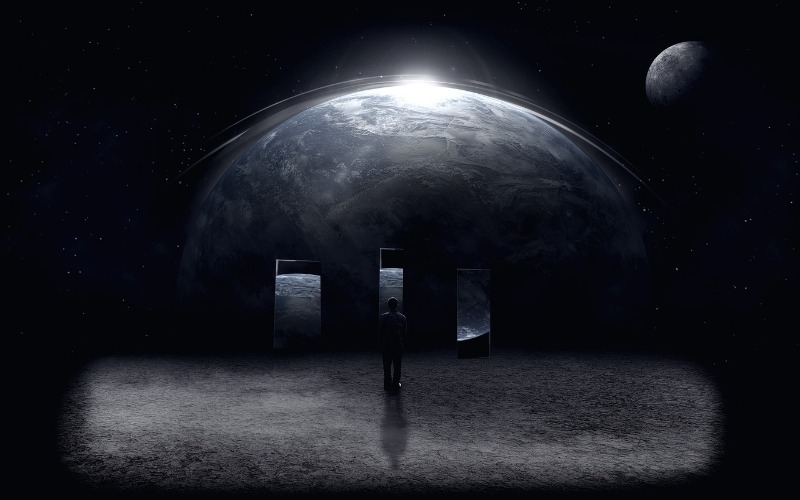The moon is a wasteland compared to Earth, but that might soon change. If climate change and environmental collapse make life on Earth unfeasible, the moon could be our closest and most convenient alternative.
Life on the moon isn’t without its problems, not least of which is how to transport the bulky building materials and machinery needed to construct livable spaces to this rocky star.
Printer Errors and Plastic Wrap: The Future of Our Lunar Landscape
Previous ideas included India’s Igloos, which according to the Indian Space Research Organisation (ISRO), could provide a long-term alternative to the discomfort of life on the International Space Station.
When Patricia Millar explored the potential of India’s igloos in a previous article, she highlighted the ease with which they could be constructed using smart materials and lunar soil.
While India’s igloos have undergone some rigorous testing and proved their ability to withstand the intense conditions in Antarctica, the latest movers and shakers think they’ve found an even better alternative for lunar living.
An Inflated Sense of Sustainable Lunar Life
Thomas Herzig, founder, and CEO of PneumoPlanet, told Space website: “All the effort and energy for 3D printing of massive walls and ceilings is not necessary,” especially when you’ve got the technology that gave us balloon animals and bouncy castles at your fingertips!
Seriously, though, PneumoPlanet is looking at creating a lunar village out of inflatable structures that can be blown up on arrival, reducing transportation costs and eliminating the associated logistics.
These inflatable structures can then be protected by a thick layer of regolith – a combination of lunar dust, soil, and broken rock found on the moon’s surface.
It may sound counterintuitive to expect a thin inflatable membrane to withstand the weight of a several-meter-thick layer of rock and dust, but this is the moon we’re talking about.
Up there, the pressure exerted by a four-meter layer of rock can be countered by creating an internal air pressure about half that found on Earth.
Unlike India’s igloos, PneumoPlanet’s design creates more than a simple shell of human habitation – it’s a self-sustainable village that can house and nourish up to 100 astronauts permanently.
The key to PneumoPlanet’s success is transporting only lightweight materials and using natural lunar resources to create an outer shell that provides insulation and protects the inflatable structure from meteorites and radiation.
The whole structure would operate self-sufficiently, using solar power to produce oxygen and food in a manner we’ve yet to perfect on Earth!
The advantage of this design is that all the materials could be transported using smaller spacecraft, rather than relying on rocket systems offering heavy transport capacity. This reduces costs significantly, enabling the project to deliver a much lower payload per m2 than previous designs.
No more need for a 3D printer or the dozens of tonnes of magnesium oxide needed to make regolith into a printable substance. Better still, the energy demands of an inflatable structure are much smaller than those needed to print an igloo using regolith.
Once constructed, the self-sufficient lunar village would recycle gases within a closed system, with the plants producing the oxygen humans require and humans exhaling the CO2 the plants need to photosynthesize.
Any organic waste products would be composted into fertile soil, creating an environment that researchers believe could see each greenhouse unit producing enough food for two humans without requiring any additional imports from Earth.
Mirroring Life on Earth with Sustainable Solar Power
Central to the design are PneumoPlanet’s mirror towers, which will capture and direct the solar power that will keep the entire village operational.
These mirrors will rotate to catch all the available sunlight and then reflect it into a crater. Inside the crater, a cone-shaped mirror reflects the light out into the greenhouse at a concentration of 65 kilowatts. This creates a light intensity of 265kw per square meter, which is ideal for photosynthesis.
As with any property, location is key, and creating a human habitat on a lunar landscape means finding a place where sunlight is plentiful but close enough to a “permanently shadowed region” (PSR) from which ice can be harvested to provide water.
Such a place does exist at the polar ends of the moon, which enjoy continual sunlight. It would also be possible to fabricate nighttime by turning the tower mirrors away from the sun, thereby creating darkness within the human habitat.
PneumoPlanet or Plastic Pollution on a New Level?
Transporting vast quantities of plastic into space may not sound very environmentally friendly. Herzig argues that the cost of transportation is so high that it makes creating garbage on the moon financially prohibitive.
Recycling and reusing waste materials would be the only way forward, but an avenue Herzig is exploring. He recommends melting, casting, or 3D printing plastics and metals on the moon, in a manner reminiscent of the building techniques he so heavily criticized.
While not without its problems, PneumoPlanet is potentially bringing the human race one step closer to finding its ultimate survival bunker – a place we can run to when, parasites that we are, we’ve finished destroying our current host planet.
What life would be like in an inflatable balloon warmed by mirrors and solar panels is anyone’s guess, but by 2050 it’s liable to be a lot more comfortable than life on Earth.










